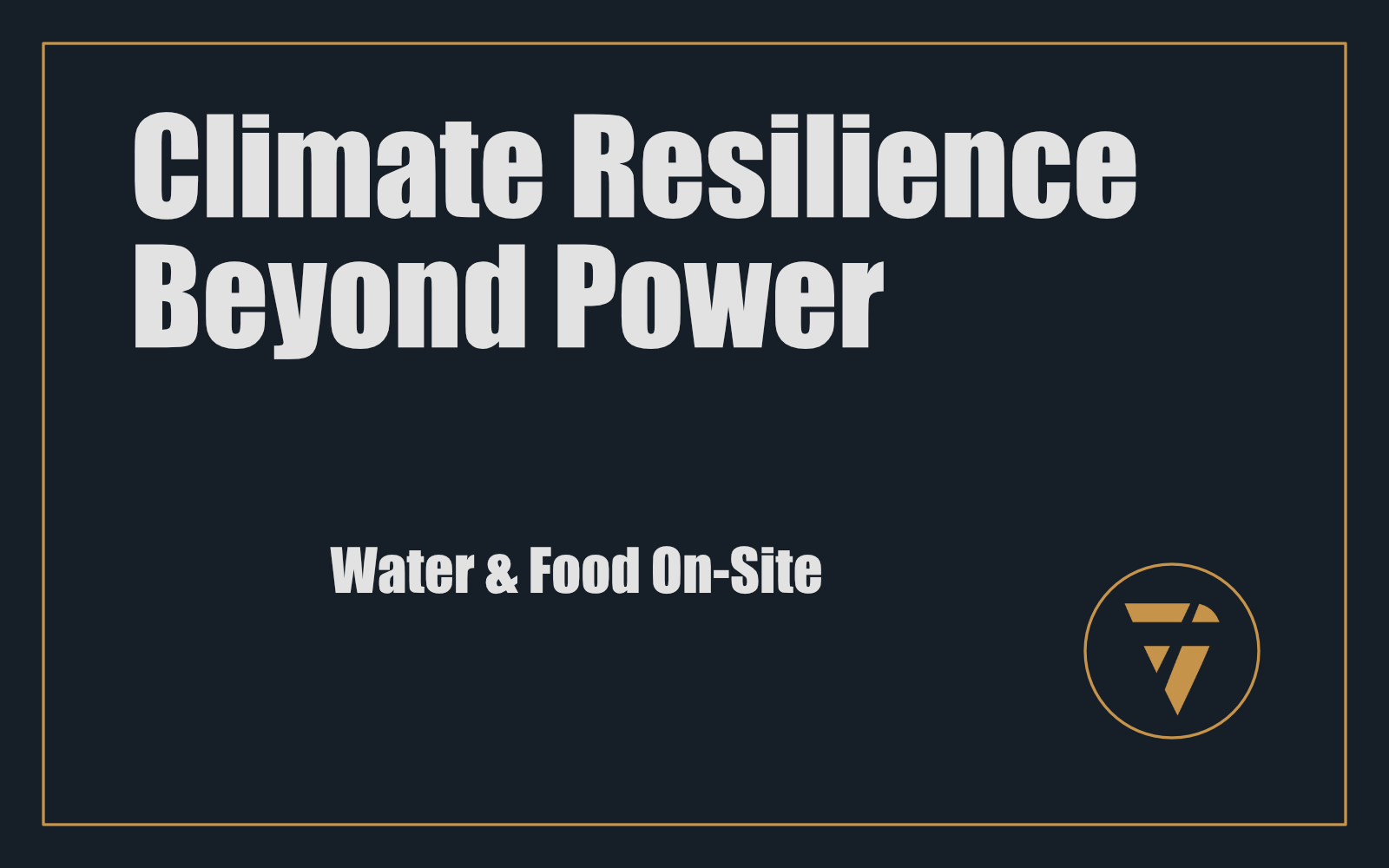Climate Resilience Beyond Power

Water & Food On-Site
Your home must feed you. Not just power you.
Water doesn’t come out of the tap unless systems hold. Food doesn’t appear in fridges unless trucks arrive. And when the climate breaks those systems—as it already has—what we call “housing” collapses.
Climate-secure housing starts with energy. But it cannot end there.
To survive disruption, a home must store water, cycle it, grow food, and protect that food without a plug. That means rain catchment, greywater reuse, root cellars, and microfarms. Not as accessories—but as infrastructure.
A house that can’t feed you, hydrate you, or cool you without electricity—is not a home. It’s a shelter until the next emergency. And it’s coming.
1. The New Survival Test: Hydration & Nutrition
When the grid fails, water and food scarcity hit fast. Municipal systems go offline. Groceries spoil. Homes fall back to single-use bottled or emergency rations. That’s not resilience; it’s luck. A climate-ready home must store life’s essentials—hydration and nourishment—on-site, always.
2. Rainwater Harvesting & Storage
- Rainwater collection: Roofs angled and plumbed with leaf guards, first-flush diverters, and dedicated cisterns.
- Storage: Underground or above-ground tanks sized to store 30–60 days of household water (approx. 1–2 m³ per person). Gravity-fed systems eliminate pumps during blackouts.
- Filtration: Passive filters—sand, charcoal, UV—ensure potable quality. You don’t need a municipal system to drink.
3. Greywater Systems & Drought-Proofing
- Rain gardens and subsurface infiltration soak shower, laundry, and sink water—watering plants or replenishing groundwater.
- Low-flush fixtures, dry/composting toilets, and leak detection systems lower demand dramatically.
- Regulatory guidance: BC Housing’s Water Conservation best practices support water-efficient plumbing layouts for multifamily buildings.
4. On-Site Food Systems: Your Personal Pantry
- Microfarms: Raised beds, vertical walls, and aquaponics systems can generate fresh veggies onsite year-round, even indoors.
- Root cellars: Passive-earth refrigerators: shaded, insulated spaces that hold potatoes, carrots, apples for months at 5–10 °C without power.
- Indoor growing walls: LED-free green walls using hydroponics or aeroponics, fit inside apartments, provide daily greens during outages.
- Local case example: Small, indoor microfarms in urban BC supported community kitchens in the 2021 heat dome—but only where pre-existing systems existed.
5. Design Guides & Global Models
- BC Housing Design Guide recommends rainwater collection and low-impact landscaping to reduce municipal strain during drought and heatwaves.
- YourHome.gov.au (Australia) highlights passive water reuse, building for climate-adaptive water independence.
- Architectural Digest features DIY root cellars and pantry systems integrated into modern homes.
- LocalHousingSolutions.org provides metrics: passive systems reduce potable demand by 40%, harvest systems provide 80 L/person/day usable water from 500 mm annual rainfall.
6. Modeling the Impact
- A family of four with a 2 m³ cistern and greywater reuse can cut municipal water demand by 70% and survive local outages for over a month.
- Indoor microfarm yields 5–10 kg vegetables/month—enough for two people’s vitamin needs in winter.
- Root cellars extend shelf-life of staples (potatoes, onions, apples) from 2 weeks (fridge) to 18 weeks, no electricity.
7. Why Add Food & Water Systems
| Risk | Conventional Home | Resilient Home |
|---|---|---|
| Heatwave + outage | Packed fridges spoil | Root cellar holds |
| Drought | Municipal rationing | Rainwater taps open |
| Supply chain shock | Store-bought only | Microfarm harvests |
| Affordability | Food/water priced by scarcity | Lower operating costs |
8. Integrating into The Table
Our homes are built to collect rain and hold life:
- Roofs sized for solar and water
- Cisterns hidden in landscape, connected to gravity-fed systems
- Kitchens adjacent to indoor farms and herbs
- Root cellars hidden underground, accessible via pantry
- Grey water irrigates food and ornamental landscapes
These aren’t add-ons. They’re built into the plan.
9. Policy & Developer Imperatives
- Require RAIN rating or equivalent for all new builds
- Mandate minimum cistern capacities per bedroom/unit
- Allow greywater reuse without over-regulation
- Incentivize root cellar planning in multi‑unit buildings
Change begins with code—but ends with survival.
Homes That Don’t Starve
A resilient home is not just powered; it feeds you.
Your walls, roofs, and landscaping should store hydration and harvest sustenance. They are the foundation—and first line—of climate security.
When you can’t shop, and the grid’s down, your home must hold life.
This is what I’m working on. Tell me what you think, I enjoy the conversation! Subscribe and follow the work in real time.
Thanks!
B

Your house must feed you. Hydrate you. Cool you.
Without the grid. Without supply chains.
Rain tanks. Root cellars. Microfarms.
If your home can’t survive on-site—neither can you.
PS -






